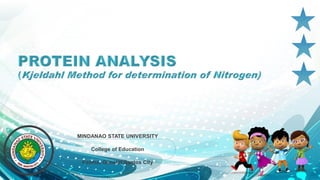
Protein analysis
- 1. MINDANAO STATE UNIVERSITY College of Education Fatima, General Santos City
- 2. The Kjeldahl method consists of three steps: A. Digestion B. Distillation C. Titration
- 3. A. Digestion of the sample Digestion is the decomposition of nitrogen in organic samples utilizing a concentrated acid solution. This is accomplished by boiling a homogeneous sample in concentrated sulfuric acid. The end result is an ammonium sulfate solution. Protein + H2SO4 → (NH4)2SO4(aq) + CO2(g) + SO2(g) + H2O(g) (1)
- 4. A. Digestion of the sample Sulfuric acid has been used alone for the digestion of organic samples. The amount of acid required is influenced by sample size and relative amount of carbon and hydrogen in the sample, as well as amount of nitrogen. A very fatty sample consumes more acid. Also, heat input and digestion length influences the amount of acid loss due to vaporization during the digestion process. Initially an organic sample usually chars and blackens. Remember that as acid is gradually consumed during digestion process, for the various reasons mentioned above, the salt acid ratio of the digest gradually rises. This means the hottest solution temperatures are attained at the end of the digestion.
- 5. A. Digestion of the sample Several catalysts have been employed by Kjeldahl chemists over the years to increase the rate of organic breakdown during the acid digestion. Mercuric oxide has been the most effective and widely used. However, mercury forms a complex with ammonium ions during digestion. The addition of sodium thiosulfate or sodium sulfide after digestion and before distillation will break the complex and precipitate mercuric sulfide.
- 6. B. Distillation Distillation is adding excess base to the acid digestion mixture to convert NH4+ to NH3, followed by boiling and condensation of the NH3 gas in a receiving solution. This is accomplished by; 1. Raising the pH of the mixture using sodium hydroxide (NaOH solution). This has the effect of changing the ammonium (NH4+) ions (which are dissolved in the liquid) to ammonia (NH3), which is a gas. (NH4)2SO4(aq) + 2NaOH → Na2SO4(aq) + 2H2O(l) + 2NH3(g) (2)
- 7. Distillation 2. Separating the nitrogen away from the digestion mixture by distilling the ammonia (converting it to a volatile gas, by raising the temperature to boiling point) and then trapping the distilled vapors in a special trapping solution of boric acid (H3BO3). The ammonia is bound to the boric acid in the form of ammonium borate complex. H3BO3+ NH3 → NH4+ + H2BO3- (3)
- 8. Distillation The majority of the NH3 is distilled and trapped in the receiving acid solution within the first 5 or 10 minutes of boiling. But depending on the volume of the digestion mixture and the method being followed, 15 to 150 ml of condensate should be collected in the receiving flask to ensure complete recovery of nitrogen. Further extension of the distillation times and volumes collected simply results in more water being carried over to the receiving solution. Excess water does not change the titration results.
- 9. Distillation The rate of distillation is affected by condenser cooling capacity and cooling water temperature, but primarily by heat input. Typically the heating elements used for distillation have variable temperature controllers. A distillation rate of about 7.5 ml/minute is most commonly cited in accepted methods. Connecting bulbs or expansion chambers between the digestion flask and the condenser is an important consideration to prevent carryover of the alkaline digestion mixture into the receiving flask.
- 10. Distillation The slightest bit of contamination of the receiving solution can cause significant error in the titration step. When very low levels of nitrogen are being determined, it is advisable to “precondition” the distillation apparatus prior to distillation. This can be done by distilling a 1:1 mixture of ammonia-free water and 50% NaOH for 5 minutes just before sample distillation to reduce contamination from atmospheric ammonia.
- 11. C. Titration: There are two types of titration: back titration, and direct titration. Both methods indicate the ammonia present in the distillate with a color change and allow for calculation of unknown concentrations.
- 12. Reagents and apparatus Potassium sulfate, K2SO4+Se tablets (2 for each digestion tube) Concentrated H2SO4 (in the hood) 35 % (w/v) NaOH for each digestion tube (already prepared). 4.0 % (w/v) Boric acid, H3BO3 (already prepared) 0.1 M HCl (already prepared, exact concentration will be given) Methyl orange (in droppers) Erlenmeyer flasks
- 13. Reagents and apparatus Burette Digestion tubes Milk: Do not forget to bring any brand of milk.
- 14. Procedure 1. Sample: 5.0 mL fresh cow’s milk in a digestion tube. 2. Reagents for digestion: to each milk sample and also to an empty digestion tube (blank) add the followings: - 2 tablets of K2SO4 + Se catalyst - 10.0 mL of concentrated H2SO4 (98%) 3. Digestion: heat for ca. 30 minutes at 420ºC. ATTENTION: Do not inhale the gases evolve in reaction 1.
- 15. Procedure 4. Cooling and diluting: let the digestion tubes to cool to 50-60 ºC and add to each add 50 mL of distilled water. ATTENTION: Let the tubes stand in air to cool, cold water may break the tubes. 5. Distillation: i. Place the digested samples in digestion tubes to the distilling unit and add 50.0 mL of 35% (w/v) NaOH. ii. The sample is distilled until 100 mL of distillate are collected in 25.0 mL of 4.0 % (w/v) boric acid.
- 16. Procedure 6. Titration: add 2-3 drops indicator to the Erlenmeyer flask and titrate it with 0.1 M HCl. 7. Calculate the amount of protein (% protein) and compare the result with the value give on the milk.
- 17. Formula
